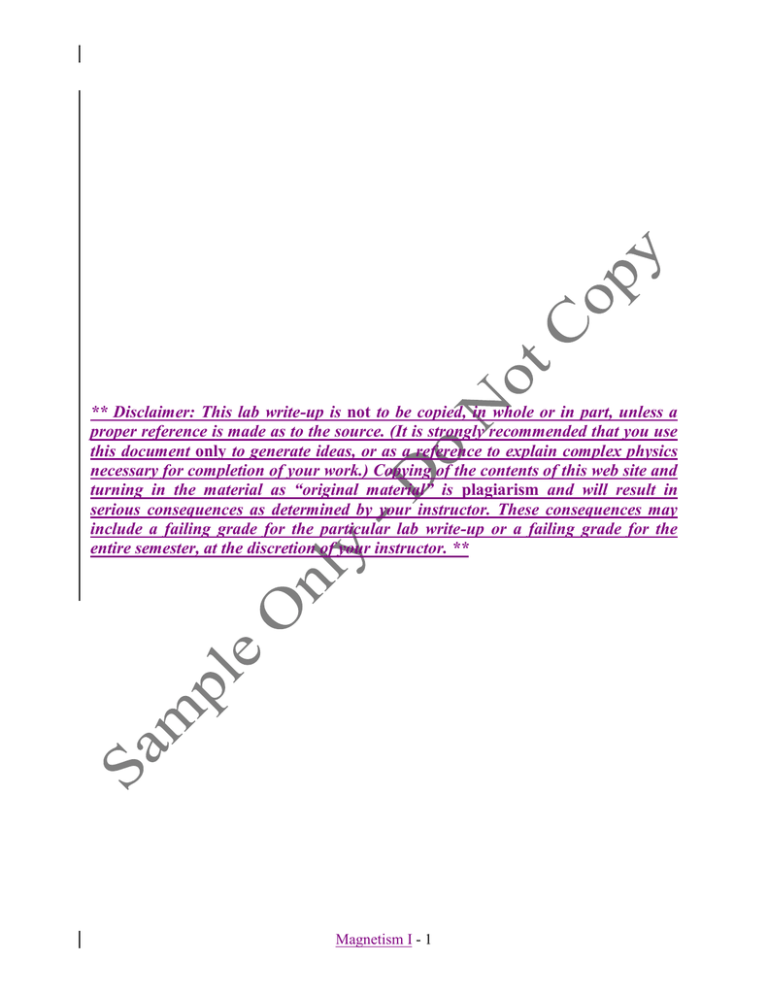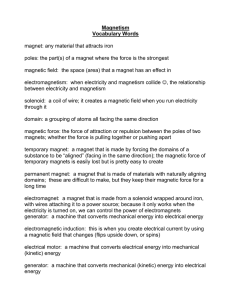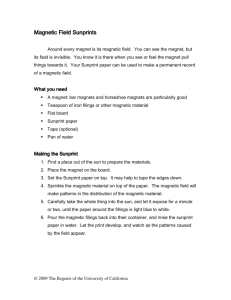** Disclaimer: This lab write-up is
advertisement

** Disclaimer: This lab write-up is not to be copied, in whole or in part, unless a proper reference is made as to the source. (It is strongly recommended that you use this document only to generate ideas, or as a reference to explain complex physics necessary for completion of your work.) Copying of the contents of this web site and turning in the material as “original material” is plagiarism and will result in serious consequences as determined by your instructor. These consequences may include a failing grade for the particular lab write-up or a failing grade for the entire semester, at the discretion of your instructor. ** Magnetism I - 1 Magnetism I Name: PES 215 Report Lab Station: Objective The purpose of this lab was to determine how the magnetic field of a permanent magnet is related to distance. Data and Calculations Part A – Canceling Out the Earth’s (and other) Magnetic Field: Since the Earth has a permanent Magnetic Field set up around it, we needed to cancel out this magnetic field strength to only capture the magnitude and direction of the magnet pair we were trying to measure. Figure 1: Magnetic Field of the Earth (Above Image Available Online at: http://www.calstatela.edu/faculty/acolvil/plates/magnetic_field.jpg) We know that the Earth’s Magnetic field is about ½ a micro-Tesla, which is sufficiently large enough to be measured by the magnetic field sensor we were using during the lab. BEarth 0.5 T 0.5 Gauss Magnetism I - 2 We zeroed out the magnetic field sensor before taking any measurements to ensure that the Earth’s Magnetic field would not superimpose with the magnet’s field (giving us an erroneous measure of the dropoff as a function of distance). Part B: Capturing the Field Strength vs. Distance for the Magnets: The following figure shows the setup of the experiment. We used a magnetic field sensor (which was pointing toward the south end of the permanent magnet pair), a ruler divided into centimeters and the two permanent magnets connected across a piece of paper (which indicated the center of mass line for the two magnets). Figure 2: Experimental setup of the Lab In half centimeter increments we measured the magnitude of the magnetic field of the magnet pair. The following is the data captured from the experiment. Distance from Sensor Magnetic Field to Magnets [m] Magnitude [T] 0.020 0.006 0.025 0.003072 0.030 0.001778 0.035 0.00112 0.040 0.00075 0.045 0.000527 0.050 0.000384 0.055 0.000289 0.060 0.000222 0.065 0.000175 0.070 0.00014 0.075 0.000114 0.080 9.38E-05 Magnetism I - 3 0.085 0.090 0.095 0.100 0.105 7.82E-05 6.58E-05 5.6E-05 0.000048 4.15E-05 Plotting Field Strength versus distance gave the following graph: Field Strength vs Distance 0.007 Field Strength [T] 0.006 0.005 0.004 0.003 0.002 0.001 0 0 0.02 0.04 0.06 0.08 Distance [m] Part C: Data Analysis and Comparison: Using Excel to get a best fit of the data points gave the following: Magnetism I - 4 0.1 0.12 Field Strength vs Distance 0.007 Field Strength [T] 0.006 0.005 0.004 y = 5E-08x-3 0.003 R2 = 1 0.002 0.001 0 0 0.02 0.04 0.06 0.08 0.1 0.12 Distance [m] Notice that the best fit line has a regression of 1, which means that the fit is extremely good. This indicates that the field is dropping off in an inverse cubic manner. As shown in the figure below, This means the further one is from the permanent magnet, the weaker the field will be from the magnet. Figure 3: Relative field intensity of a permanent magnet as a function of distance. The best fit line provides the following trendline function: y 5.0 10 8 Tm x1 3 Relating the coefficient to the field expression for a magnetic dipole, we see that: o 2 kgm3 5.0 10 8 4 As 2 ** WARNING: Watch your units! Be sure you know whether you are using mT or T and cm or m. Use your value of the coefficient to determine the magnetic dipole moment µ of your magnet, if the inverse-cube model fits your experimental data. ** Magnetism I - 5 2 1 Baxis o 3 4 x o 2 kgm3 5.0 10 8 4 As 2 4 kgm3 5.0 10 8 As 2 2 o 3 4 5.0 10 8 kgm As 2 7 kgm 2 4 10 A2 s 2 0.25 Am 2 If a single current loop had the same radius as our permanent magnet, what current would be required to create the same magnetic field? IA Radius of Magnets [m] 0.007 The cross-sectional area is calculated by: A r 2 0.007 m 2 A 1.539 10 4 m 2 IA Magnetism I - 6 0.25 Am 2 I 1624.4314 A A 1.539 10 4 m 2 I 1624.4314 A Are there currents flowing in loops in the permanent magnet? We discussed that the equation above should really look like the one below. Where N is the number of loops. Assume that the number of loops is on the order of 3,000-ish. Does this give what seems like a more reasonable answer for the current based upon what we know from previous labs? NIr 2 Results and Conclusions: You write the details. Include your answer here. Use complete sentences!!!! ** NOTE: There are several components of error which could significantly modify the results of this experiment. Some of these are listed below: Tilt of the Magnets (see descriptions from PES 115) Earth’s Magnetic Field Interference Metal Table (Faraday’s Law) Others (You’re intelligent scientists – come up with other possible reasons) Magnetism I - 7






